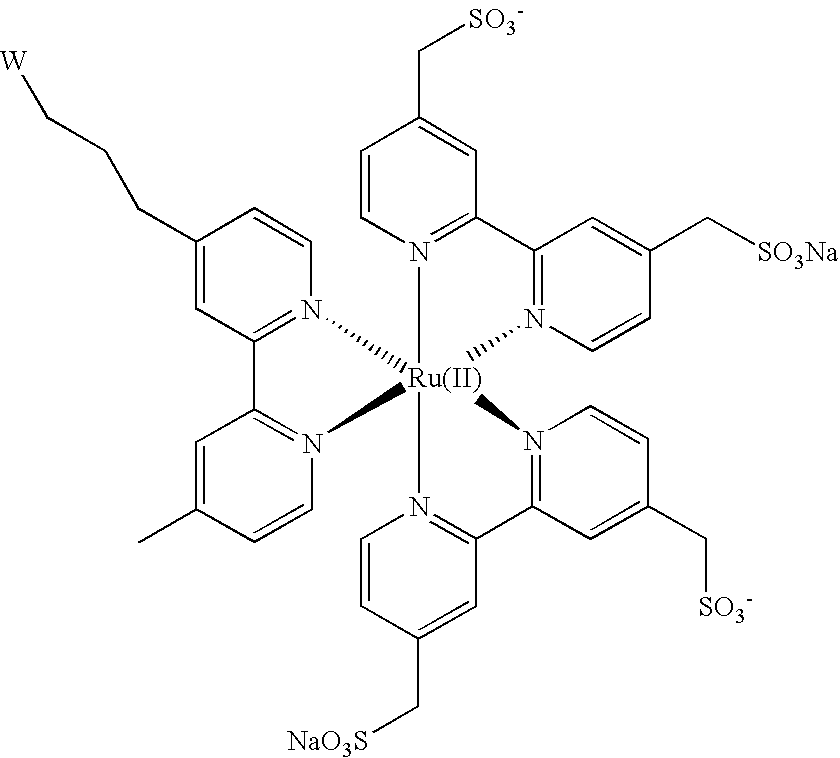Methods and compositions for detecting Bacillus anthracis
a technology of bacillus anthracis and composition, which is applied in the field of methods and compositions for detecting bacillus anthracis, can solve the problems of inability to rapidly detect spores, inability to grow colonies on agar, and inability to meet the requirements of agar storage time,
- Summary
- Abstract
- Description
- Claims
- Application Information
AI Technical Summary
Benefits of technology
Problems solved by technology
Method used
Image
Examples
example 1
Identification of B. anthracis-specific Genomic Sequences
[0153] Segments of B. anthracis DNA that would be suitable targets for diagnostic assays were verified using the BLAST homology search program, available at http: / / www.ncbi.nlm.nih.gov / BLAST to compare the sequence of a virulent strain (Ames) of B. anthracis to all known bacterial DNA sequences using the “Genbank nr” database of sequences. B. anthracis nucleotide sequences were randomly inserted into BLAST searches of the Genbank nr database. Nucleic acid sequences in B. anthracis that have little identity to gene sequences of other bacteria, and are therefore good targets for detecting B. anthracis, were identified. The bit scores for non-anthracis sequences were less than 100. The bit scores for the identified B. anthracis sequences were 4948, 2658, and 2529 for SEQ ID NOS. 1, 2, and 3, respectively.
[0154] These sequences, set forth in SEQ ID NOS. 1, 2, and 3, were segments from the complete DNA sequence of B. anthracis Am...
example 2
Detection of B. anthracis-specific Nucleic Acid Sequences Using a Combination of PCR and ECL Detection
[0159] This example describes the use of ECL-labeled primers to detect B. anthracis, comprising labeling one of the PCR primers with [Ru(bpy)3]2+. The primers set forth in SEQ ID NOS. 4 and 5 were used. The primer SEQ ID NO. 5 was labeled by adding [Ru(bpy)3]2+ to the 5′-end of the oligonucleotide primer during synthesis using a [Ru(bpy)3]2+ phosphoramidite as described in Gudibande et al., U.S. Pat. No. 5,686,244. Amplicons were generated using the PCR protocol described above on DNA isolated from B. anthracis, E. coli, B. subtilis, or B. cereus.
[0160] An oligonucleotide was prepared that was complementary to the amplicons obtained by using the above primers in a PCR reaction. This capture oligonucleotide was synthesized to be complementary to a 20-base region between the PCR primers. The capture oligonucleotide sequence was 5′-amineAATCAGCCAATCAACATTAA (SEQ ID NO. 8). The captur...
example 3
Demonstration of the Generality of the PCR Specificity
[0163] To test additional sites throughout the nucleotide sequences of SEQ ID NOS. 1 and 2 for B. anthracis specificity, the following pairs of PCR primers were designed based on these two sequences:
5′-TCGGGAAGAGGGTTTACAGAA(SEQ ID NO. 9)5′-AAAGGTTTCCACCGTGTTGCT;(SEQ ID NO. 10)5′-AAGGACCACATCATAACAATC(SEQ ID NO. 11)5′-AACTTCATATCTTCACCCATC;(SEQ ID NO. 12)5′-TAACACCTGCGACAAACTGAA(SEQ ID NO. 13)5′-CAAGACCACGAGGAATACCAA;(SEQ ID NO. 14)5′-ACTTGGTATTCCTCGTGGTCT(SEQ ID NO. 15)5′-CACTTAATGTTGATTGGCTGA;(SEQ ID NO. 16)and5′-CAGGTGATTATACTGCCAACG(SEQ ID NO. 17)5′-AAAGGCTTCCTTCTAGTTCAT.(SEQ ID NO. 18)
[0164] Each of the above primer pairs were used in PCR reactions with B. anthracis DNA (Sterne strain) as a positive control. Genomic DNA samples from forty-three other bacteria, listed in Table 1 below, were used as negative controls. Each reaction was performed in a 25 μl volume containing 10 mM Tris-HCl pH 8.3, 50 mM KCl, 2 mM MgCl2, 0.2 m...
PUM
| Property | Measurement | Unit |
|---|---|---|
| temperature | aaaaa | aaaaa |
| temperature | aaaaa | aaaaa |
| temperature | aaaaa | aaaaa |
Abstract
Description
Claims
Application Information
 Login to View More
Login to View More - R&D
- Intellectual Property
- Life Sciences
- Materials
- Tech Scout
- Unparalleled Data Quality
- Higher Quality Content
- 60% Fewer Hallucinations
Browse by: Latest US Patents, China's latest patents, Technical Efficacy Thesaurus, Application Domain, Technology Topic, Popular Technical Reports.
© 2025 PatSnap. All rights reserved.Legal|Privacy policy|Modern Slavery Act Transparency Statement|Sitemap|About US| Contact US: help@patsnap.com



